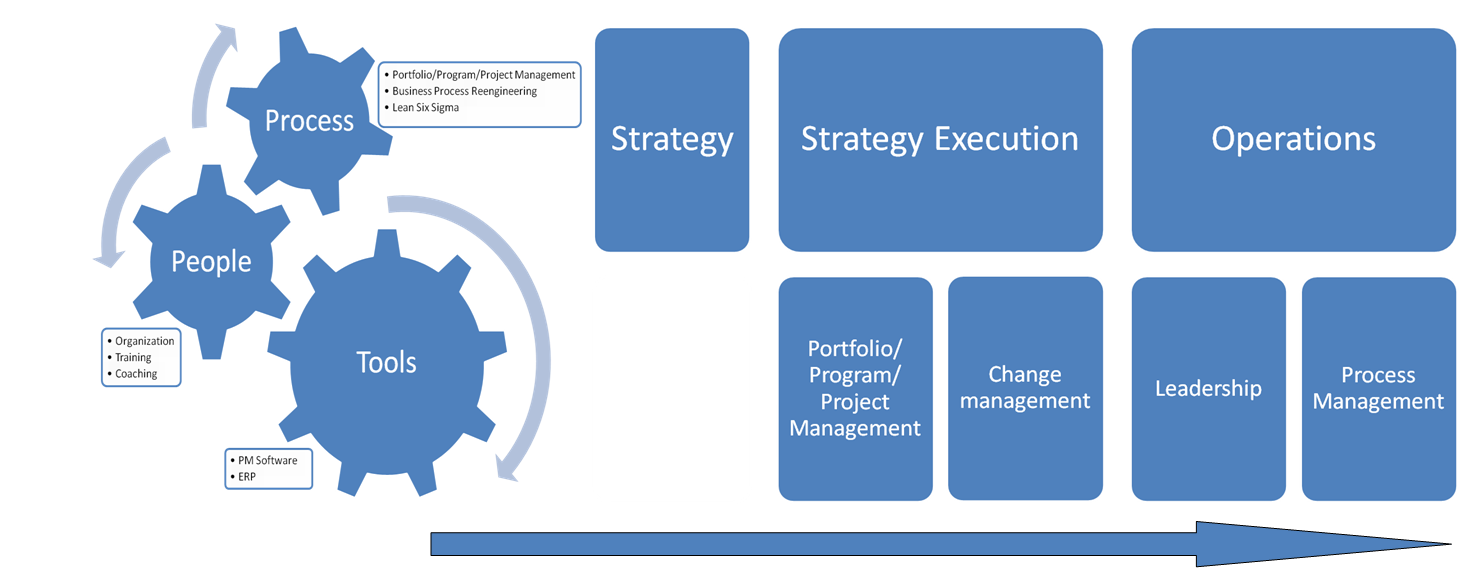

Professionalize your organization to achieve sustainable performance
This article is the first part of a serie focusing on the performing organization. Companies reaching a certain size (about 50 people) soon or later realize that they need to “structure” the organization to grow further. What used to work when smaller may no longer work, as the company needs to ensure that the service provided does not depend on specific individuals and that goals can be consistently met across the organization.
Performance is about consistently reaching these business goals.
First question that comes to mind is: What are the goals the company needs to achieve ? The majority will immediately think of the usual suspects, like the profitability, liquidity and solvability. The issue is that these basic financial indicators look at the past, not the future, even though precious time is sometimes spent to build the most accurate forecasts. Now that the world is continuously changing (and fast), the old technique of preparing a budget based on last year’s and adding a small increase (the inflation?) can no longer apply. We also need forward-looking KPIs covering the value chain that will provide a full view of the company health, not only short-term financials.
Tip #1: Build your company dashboard across the value chain
How many companies use a dashboard focusing mostly on financial indicators? EBITDA, Return on Equity, Debt-Equity ratio, Cash-Flow needs, etc. must of course be monitored, but are these enough to provide a full picture of the company health ? Financial figures focus mostly on the past, they do not look forward to the future. For example, having a good view on your project portfolio health can help you forecast better your future performance, not only the current one. Additionally, it is useful to get a picture of all departments within the organization. Focusing on the entire value chain provides such an overview.
Here follow a few ideas on areas to monitor:
- Strategy: having a few indicators on your portfolio health, checking appropriate balance between projects types and risk levels.
- Corporate Social Responsibility: ensuring that the company is environment-friendly is now a priority for shareholders and communities alike; giving back to society as well, e.g. by giving time to employees to participate to community projects, like helping children at school.
- R&D: does the company invest enough in innovation, does it leverage knowledge available outside the organization?
- Purchasing: do we respect our suppliers payment terms? is our inventory turnover competitive?
- Production: are we using our capital expenditure efficiently ?
- Sales: how fast do we collect payments from our customers ? What percentage of ours sales is made with new products and/or customers ? How often can we deliver our customers on time?
- HR: how does our employee turnover compare with other companies in our sector? Do we offer our employees enough training?
What are the indicators you use to run your business?
In order to achieve sustainable performance, a business excellence framework can be useful. The definition of business excellence on Wikipedia.org says: Business excellence is the systematic use of quality management principles and tools in business management, with the goal of improving performance based on the principles of customer focus, stakeholder value, and process management. Key practices in business excellence applied across functional areas in an enterprise include continuous and breakthrough improvement, preventative management and management by facts. Some of the tools used are the balanced scorecard, Lean, the Six Sigma statistical tools, process management, the Baldrige Criteria for Performance Excellence and project management.
This definition highlights some key fields along a typical business performance lifecycle:

Tip #2: Grow best practices along the business performance cycle
- Strategy: Business leaders define a way to achieve the goals of the organization. A number of initiatives are proposed to support this strategy, with a varying level of risk, cost and internal resources.
- Strategy Execution: Initiatives are analyzed and portfolio management helps decide which ones will enter the “project pipeline”. From this moment, projects are monitored and any major variance on time, costs or benefits triggers a decision for continuing or abandoning the project. Key skills here are portfolio management, project management and change management.
- Operations: once the project has delivered the product/service/improvement expected, continuous operations of these results have to be guaranteed. Key skills here are process management and leadership.
Basically, excellence focuses on two aspects:
1. Doing the right things : Effectiveness
2. Doing things the right way: Efficiency
Strategy and Portfolio Management focus on effectiveness, and Project & Process Management focus on efficiency.
Tip #3: Engage your staff early on
Mastering effectiveness and efficiency areas, will get you on the way to excellence. When one reaches excellence, one gets room/energy for more opportunities & results.
But deployment and utilization of processes and tools are strongly depending on your staff engagement to do it. Therefore, focusing your attention on the human impact of any change is as crucial as the change in itself. Keeping, or even better, increasing the motivation of your staff when implementing new tools and processes, i.e. by including them in operational decisions, is an incredible enabler of organizational performance. Adaptive management, leadership by motivation, empowerment or self-governing teams are example of best practices supporting the way to business excellence.
Articles on the same topic:
First step to Business Excellence: a sound Strategy